(A) STUDIO SESSIONS
Session #33 New York, 20/January/1939, Billie Holiday & Her Orchestra (CD: Complete in Columbia vol.5, tk11-12)
Charlie Shavers (tp) Tyree Glenn (tb) Chu Berry (ts) Sonny White (p) Al Casey (g) John Williams (b) Cozy Cole (d) Billie Holiday (v)
This year opens with two tracks by the Vocalion label. This session is a relief, as we are back to a smaller group better suitable to Billie style. Charlie Shavers joins Lady for the first time; he will record 32 tracks with her, most in the fifties.
(MT 106) That’s All I Ask Of You ** Listen to Chu Berry’s solo in the bridge. At the end, Shavers experiments the obbligati that will later make him famous. A pleasant rendering of Billie.
(MT 106a) That’s All I Ask Of You (alternate take)
The image below is from the original 78rpm disk. Click here to listen.
(MT 107) Dream Of Life * a song by Carmen McRae, who years later would record a CD – tribute to Lady Day. Notice Sonny White solos in the bridge – by that time, he accompanied Billie in her presentations at the Café Society.
The image below is from the original 78rpm disk. Click here to listen.
Session #34 New York, 30/January/1939, Teddy Wilson & His Orchestra (CD: Complete in Columbia vol.5, tk.13-16)
Roy Eldridge (tp) Ernie Powell (cl) (ts) Benny Carter (as) (ts) Teddy Wilson (p) Danny Barker(g) Milt Hinton string (b) Cozy Cole (d) Billie Holiday (v)
Fortunately Teddy arranged a small band for this session, the last he will conduct under Brunswick label and with John Hammond as producer. The end of a classic era! (Wilson will be back shortly in the next year for two more sessions, just before the end of Columbia years).
(MT 108) What Shall I Say? ** Eldridge is back and it’s his, together with Carter, the wonderful solo in the opening.
The image below is from the original 78rpm disk. Click here to listen.
(MT 109) It’s Easy To Blame the Weather
(MT 110) More Than You Know ** a standard by Vincent Youmans, lyrics by William Rose. Teddy Wilson masters the solo in the long final sequence, followed by Carter and Eldridge. A beauty. To regret Billie does not come back for a final chorus – wish we had half a minute more…
(MT 110a) More Than You Know (alternate take)
The image below is from the original 78rpm disk. Click here to listen.
(MT 111) Sugar
Session #35 New York, 21/March/1939, Billie Holiday & Her Orchestra (CD: Complete in Columbia vol.5, tk.17-21)
‘Hot Lips’ Page (tp) Tab Smith (ss, as) Kenneth Hollon, Stanley Payne (ts) Kenny Kersey (p) Jimmy McLin (g) John Williams (b) Eddie Dougherty (d) Billie Holiday (v)
A session with unusual five recorded tracks. Several musicians came from Café Society band. Vocalion’s producer is still Bernie Hanighen from ARC. The musical selection does not help and the band has grown to four horns. The four first tracks were issued by Vocalion, but the 5th (MT 116) would only be issued by Columbia years later.
(MT 112) You’re Too Lovely To Last
(MT 112a) You’re Too Lovely To Last (alternate take)
(MT 113) Under A Blue Jungle Moon *
(MT 113a) Under A Blue Jungle Moon (alternate take)
The image below is from the original 78rpm disk. Click here to listen.
(MT 114) Everything Happens For The Best – the first solo in the bridge is by Tab Smith in the soprano sax, an unusual instrument. He is also the composer, with Billie.
(MT 115) Why Did I Always Depend On You? ** notice the solo in the bridge by Hot Lips, who played only few tracks with Billie.
The image below is from the original 78rpm disk. Click here to listen.
(MT 116) Long Gone Blues ** possibly, the group took the time to record an extra track, edited by Columbia only 8 years later. The blues style is quite different from the rest of the session, a strong lament. Maybe this is part of Café Society repertoire. After a brief intro, Billie opens the chorus in a glorious way (Talk to me babe, tell me what’s the matter now…) At the bridge, Tab Smith solos with the soprano and Hot Lips closes with an incredible sound of his instrument.
The image below is from the original 78rpm disk. Click here to listen.
COLUMBIA RECORDS & BRUNSWICK
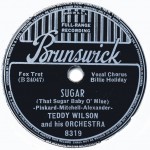 In December 1938 Columbia Broadcast System (CBS) buys ARC and the Columbia label will progressively replace Brunswick, definitely discontinued in April, 1940. The last Billie session for this label took place in January, 1939 (see Sugar, session #34). On the other hand, Vocalion label will survive till 1940, when it was replaced by OKeh, dedicated to Rhythm & Blues (images © Cross Taro Collection, Tokyo)
In December 1938 Columbia Broadcast System (CBS) buys ARC and the Columbia label will progressively replace Brunswick, definitely discontinued in April, 1940. The last Billie session for this label took place in January, 1939 (see Sugar, session #34). On the other hand, Vocalion label will survive till 1940, when it was replaced by OKeh, dedicated to Rhythm & Blues (images © Cross Taro Collection, Tokyo)
COMMODORE RECORDS
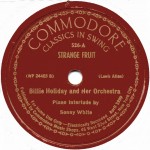 In the meantime, Billie’s success at Café Society motivated the poet Lewis Allen to look for Billie and offer her an unpublished song, Strange Fruit, that would turn into a great success. However, Columbia had no intention to record it due to the peculiar racial theme. Billie then presented the song to her friend Milt Gabler (*), who had recently founded his own label, Commodore Records. They both asked Columbia permission for an independent recording and CBS, surprisingly, agreed in what resulted to be the next session.
In the meantime, Billie’s success at Café Society motivated the poet Lewis Allen to look for Billie and offer her an unpublished song, Strange Fruit, that would turn into a great success. However, Columbia had no intention to record it due to the peculiar racial theme. Billie then presented the song to her friend Milt Gabler (*), who had recently founded his own label, Commodore Records. They both asked Columbia permission for an independent recording and CBS, surprisingly, agreed in what resulted to be the next session.
(*) see at page’s foot the fascinating Milt Gabler history.
Session #36 New York, 20/April/1939, Frank Newton & Café Society Band (CD: Complete Commodore vol.1, tk.1-4)
Frank Newton (tp) Tab Smith (as) Kenneth Hollon e Stanley Payne (ts) Sonny White (p) Jimmy McLin (g) John Williams (b) Eddie Dougherty (d) Billie Holiday (v)
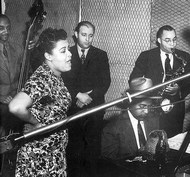 Billie recorded this session for Commodore but, just after, signed a new contract with CBS. She will be back to that label years later, in 1944 (see session #48). This session counts with several new faces with the exception of Sonny White, her beloved pianist. The musical selection is first quality but unfortunately the sound quality – specially the microphones – and the overall results are below average. Maybe Commodore, in its beginning, couldn’t afford the same equipment as CBS or RCA nor attain an equipment lease.
Billie recorded this session for Commodore but, just after, signed a new contract with CBS. She will be back to that label years later, in 1944 (see session #48). This session counts with several new faces with the exception of Sonny White, her beloved pianist. The musical selection is first quality but unfortunately the sound quality – specially the microphones – and the overall results are below average. Maybe Commodore, in its beginning, couldn’t afford the same equipment as CBS or RCA nor attain an equipment lease.
(MT 117) Strange Fruit – this song was a success in Billie’s presentations at the Café Society with its strong message against lynching. It is not, however, in my favorites list.
(MT 117a) Strange Fruit (alternate take)
The image below is from the original 78rpm disk. Click here to listen.
No (tp), (as) and Stanley Payne (ts)
(MT 118) Yesterdays – a wonderful standard by Jerome Kern, lyrics by Otto Harbach, for the musical Roberta. However, here the sound is awful, with lots of noise in the background and a poor equalization that makes Billie’s voice sound over the band. The alternate take is better preserved, but unfortunately is half a minute shorter. In a later interview, Billie mentioned this song as one of her favorites, but, as in the case of Fine and Mellow, she never made a good recording of it.
(MT 118a) Yesterdays (alternate take)
The image below is from the original 78rpm disk. Click here to listen.
- There’s a second studio register in 1952 (s.MT #237) and a live session in November, 1956 at the Carnegie Hall (see below). But no one of them deserved a star.
With the Full Band
(MT 119) Fine And Mellow – this song, a Billie Holiday composition, was edited as Strange Fruit’s B side. It was written in the night before the recording session, and it ended to be one of her most characteristics tunes. In this session, however, the funereal tempo and the sound quality did not render a good result. It is a pity that Lady never made a decent studio recording of this song, so representative of her live presentations.
The image below is from the original 78rpm disk. Click here to listen.
- Fine And Mellow was quite commom in later presentations. We know 11 live registers. Among them her appearance at the Carnegie Hall in November 10, 1956 (live recordings #173) and, in one of her best live records ever, the wonderful presence in the live telecast of The Sound Of Jazz, a CBS TV Program in December 8, 1957 (live recordings, session #193)
(MT 120) I Gotta Right To Sing The Blues * a fine standard by Harold Arlen, lyrics by Ted Koehler, the best track of the pack. Listen to the piano and sax solos in the bridge.
(MT 120a) I Gotta Right To Sing The Blues (alternate take)
The image below is from the original 78rpm disk. Click here to listen.
Note: see other Commodore sessions in 1944 (MT 161)
Session #37 New York, 05/July/1939, Billie Holiday & Her Orchestra (CD: Complete in Columbia vol.6, tk.1-4)
Charlie Shavers (tp) Tab Smith (ss) (as) Kenneth Hollon, Stanley Payne (ts) Sonny White (p) Bernard Addison (g) John Williams (b) Eddie Dougherty (d) Billie Holiday (v)
Billie is back to Columbia, under a new contract. The people and the style with plenty of horns are maintained in this session, very similar to the previous session in March. The label is Vocalion’s.
(MT 121) Some Other Spring * a song by Arthur Herzog, lyrics by Irene Kitchings. She is a close friend of Billie and Teddy Wilson’s ex-wife. Billie has always referred to this song as one of her favorites. She would record it again in 1956 (MT 275) with better results.
The image below is from the original 78rpm disk. Click here to listen.
(MT 122) Our Love Is Different
(MT 123) Them There Eyes – an standard by Maceo Pinkard & William Tracy ruined in this track with a too brisk tempo. A second recording in 1949 (s.MT #207) would render no better results. In live presentations from 1949 on, it will be one of the most frequent; other 11 live registers are known.
(MT 124) Swing, Brother, Swing – only to mention the solo by Charlie Shavers in the bridge, well, Hollon is also there. You may notice among my comments that I really do not enjoy those brisk tempos, Dixieland style.
Session #38 New York, 13/December/1939, Billie Holiday & Her Orchestra (CD: Complete in Columbia vol.6, tk.5-8)
Buck Clayton, Harry `Sweet` Edison (tp) Earle Warren (as) Lester Young (ts) Jack Washington (as)(bs) Joe Sullivan (p) Freddie Green (g) Walter Page (b) Jo Jones (d) Billie Holiday (v)
Two standards and two unknown songs balance this session with many horns (two trumpets and three saxes) However, Buck and Lester are back – together!
(MT 125) Night And Day – one of Cole Porter’s jewels, written in 1932 for the play Gay Divorce. Billie, however, doesn’t match the exceptional Fred Astaire’s recording for the play and, also, that of Frank Sinatra who took possession of it. I don’t like either the variations Billie brings to the music maybe because, as she declared in her book, “she had never listened the song before”.
(MT 125a) Night And Day (alternate take)
The image below is from the original 78rpm disk. Click here to listen.
(MT 126) The Man I Love * this rendering of Billie is not among her best recordings and the excess of brass in big band style doesn’t help. It is a waste of excellent material and Billie unfortunately would never record it again in studio. Lester’s solo in the bridge worth the track. This is one of my favorite songs and such a classic by George & Ira Gershwin deserves a star.
The image below is from the original 78rpm disk. Click here to listen.
(MT 127) You’re Just A No Account * it is worth to hear Buck and Lester solos
The image below is from the original 78rpm disk. Click here to listen.
(MT 128) You’re A Lucky Guy
(B) LIVE SESSIONS
Live session #4 [live recording] New York 17/January/1939 Benny Goodman & his Orchestra (CD Perfect Complete Collection vol.1 or Complete on Columbia, vol.7)
Ziggy Elman,Chris Griffin, Cy Baker or Irving Goodman (tp) Red Ballard, Vernon Brown (tb) Hymie Schertzer, Noni Bernardi (as), Jerry Jerome, Art Rollini(ts) Benny Goodman(cl) Jess Stacy(p) Ben Heller(g) Harry Goodman (b) Buddy Schutz(d) Martha Tilton, Johnny Mercer, Billie Holiday and Leo Watson(v)
(LR 5) I Cried for You – A big-band arrangement don’t really get the best of Billie.
Original LP Queen disc Q-016 Benny Goodman, His Stars And Guests (Italy, 1978). Sound not available.
(LR 6) Jeepers Creepers – This is quite an unusual track, Billie sharing the vocals with 3 other singers. Martha Tilton opens, followed by the tune composer, Johnny Mercer. Billie then takes over and, (according to the announcer) the amazing dr. Leo Watson closes with his characteristic “scats”. Billie never recorded it in studio, being this the sole live known register. Some rehearsals can also be found in the Verve collection.
Unissued in vinyl.
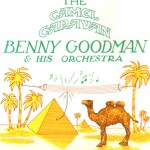 Camel Caravan Radio Show Broadcast. Camel Caravan was a radio program from 1933 to 1954. The name comes from Camel cigarettes as the show was sponsored by the tobacco company. In that era being sponsored by a tobacco company was relatively common. Several jazz musicians and crooners performed on the show. It had some role in the careers of Benny Goodman, Georgia Gibbs, and Vaughn Monroe (© Wikipedia).
Camel Caravan Radio Show Broadcast. Camel Caravan was a radio program from 1933 to 1954. The name comes from Camel cigarettes as the show was sponsored by the tobacco company. In that era being sponsored by a tobacco company was relatively common. Several jazz musicians and crooners performed on the show. It had some role in the careers of Benny Goodman, Georgia Gibbs, and Vaughn Monroe (© Wikipedia).
Live session #5 [live recording] New York 1st/April/1939 Frank Newton Orchestra (CD: box Perfect Complete Collection vol.1)
Frank Newton (tp) Stanley Payne (as) Kenneth Hollon (ts) Kenny Kersey (p) Ulysses Livingston (g) John Williams (b) Eddie Dougherty (d) Billie Holiday (v)
Cafe Society broadcast.
(LR 7) I’m Gonna Lock My Heart
Unissued in vinyl.
Café Society was a New York City nightclub opened in 1938 in Greenwich Village by Barney Josephson to showcase African American talent and to be an American version of the political cabarets he had seen in Europe before the war. Josephson also intended the club to defy the pretensions of the rich; he chose the name to mock Clare Booth Luce and what she referred to as “café society”, the habitués of more upscale nightclubs. Josephson not only trademarked the name, which had not been trademarked by the gossip columnist for the New York Journal American M, who wrote as the first “Cholly Knickerbocker”. but advertised the club as “The Wrong Place for the Right People.” Josephson opened a second branch on 58th Street, between Lexington and Park Avenue, in 1940. The club also prided itself on treating both black and white customers equally, unlike many venues, such as the Cotton Club, that featured black performers but barred black customers. The club featured many of the greatest black musicians of the day, from a wide range of backgrounds, often presented with a strongly political bent. (© Wikipedia).
(*) MIlt Gabler
Milton Gabler (1911-2001) was born in Harlem, New York and at age 15 began working in his father’s radio shop on 42nd Street, what he soon turned into the Commodore Music Shop, that became a hangout for jazz musicians. In 1937 he opened a branch on 52nd Street, next to a jazz club, where he organized a series of jam sessions. Some of them he was willing to record, thus giving rise to a new label, Commodore Records. His role as music producer soon assumed his main attention and several important jazz artists of the time passed through his record label.
Billie Holiday
A friend and regular customer was Billie Holiday, then signed with Columbia Records. She was also highly successful at her shows at Café Society, which opened in 1938 in Greenwich Village as the city’s first “integrated” night club (see above). At this time, Billie was offered the song “Strange Fruit” composed by Abel Meeropol under the pseudonym Allan Lewis. Introduced at her concerts, due to her anti-racist touch it soon became the apotheotic closing anthem for her shows in early 1939. Moved by success, Billie offered the song to Columbia, that declined. Billie then sought out Gabler, who was up to the challenge. Together, they asked Columbia for permission, surprisingly granted. The recording session at Commodore took place on April 20, 1939 which resulted in two 78rpm. The song made history. In 1999 it was awarded by Time Magazine as the “Song of the Century”.
Decca Years
With the success of Commodore Records, the market soon realized Gabler’s competence as a producer. So, in 1941 he was signed by Decca Records, one of the big ones at the time. Artists such as Lionel Hampton and the historic joint recording of Ella Fitzgerald and Louis Armstrong passed through it. Billie would return to recording for Commodore three more sessions between March 25 and April 8, 1944. A few months later, Billie would sign a contract with Decca where she would remain for the next six years. Fifteen sections with fourteen different bands would produce a variable result, despite the studio’s excellent technical quality.
Rock and roll
Gabler would still show his genius when signing Bill Halley & His Comets for Decca. The first recording session in April 1954 included “Rock Around The Clock”. To everyone’s surprise, it broke out and reached #1 on Billboard in the week of July 9, 1955, where it stayed for the next 8 weeks. The book “The Billboard book of USA NUMBER ONE HITS” released in 1988 by Guinness Books pays him due tribute by granting him its first page. In the comments the editor said: “It would have been impossible to know that Halley’s number one single created a dividing line between all the came before and all that followed. It is only from our perspective three decades later that we can see the impact that song had on our culture. It was the beginning of the rock era”.
I can give my personal testimony. One night I, at the age of eight, was at home when my father came home from work. Suddenly I heard a different song that I had never heard before. I went downstairs like a rocket. My father had a record on the record player. I asked:
– Dad, what is this?
– I don’t know – he said – I won it from a customer, who told me it was new. Did you like it?
From that day on, I played it maybe a thousand times. (Paulo Novaes)
© www.billieholidaysongs.com (rev. June 2021)

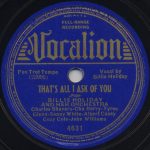
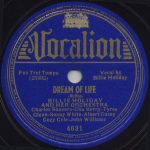
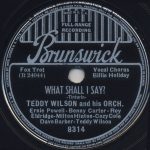
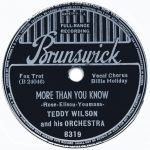
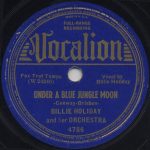
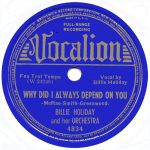
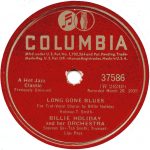
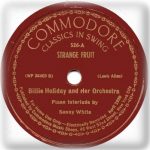
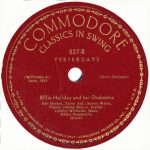
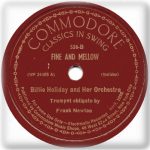
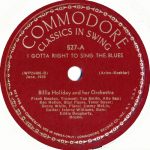
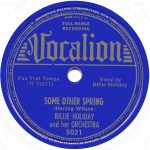
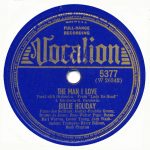
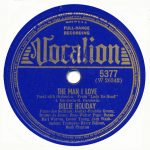
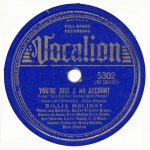
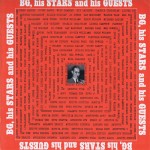
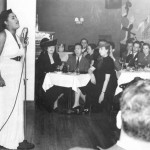
Thanks so much for this info. I’m a huge fan of these sessions, having discovered them after researching the wonderful piano playing I heard, in Ella Fitzgeralds “All My Life”. Of course the piano player was Teddy Wilson. From that research I discovered Lester, Billie and the whole cast of magnificent musicians. I was not surprised to learn that the Gershwins wrote ” The Man I Love ” .This captivating melody ranks among my favorites. ” When your smiling” is a tune I just can’t get enough of. I wish it would never end. To think, all these musicians were in their early 20’s when they created this stuff is unreal. This music bolsters my belief that artists do their best work early in their careers. Long story short, words cannot describe the pleasure I derive from listening to these supremely talented musicians play these wonderful melodys.
You’re very welcome. Keep in touch.
“this rendering of Billie is not among his best recordings” – typo on “his”?
Thanks, correction made.
When I lived in Germany in ’73, my roommate had a record that I recall was Billie and the Benny Goodman Quintet. It was my first exposure to her and I would love to find a copy now, but do not see it. Is that from a different session that you refer to above, with the BG Orchestra? Do you know if the recording is available?
Thanks
Philip
dear Philip,
From what you describe (Benny Goodman Quintet) I presume it was a BG’s compilation, not BH’s record.
Actually, there are only two sessions with Billie and BG Orchestra. The one in 1939 you described (that was a live session, radio transmitted and recorded) and the very first BH studio session in 1933. None with the so-called Quintet, but with the Orchestra. 4 tracks in total.
The two sessions I mentioned are found in the 10-disc CD-set Billie Holiday Complete in Columbia that you may find in Amazon. Hundreds of tracks. It worth every penny.
Note also that Goodman alone, as an instrumentist, took part in a dozen more tracks, in different bands, but that cannot be considered BG quintets, of course.
Good luck.
Paulo